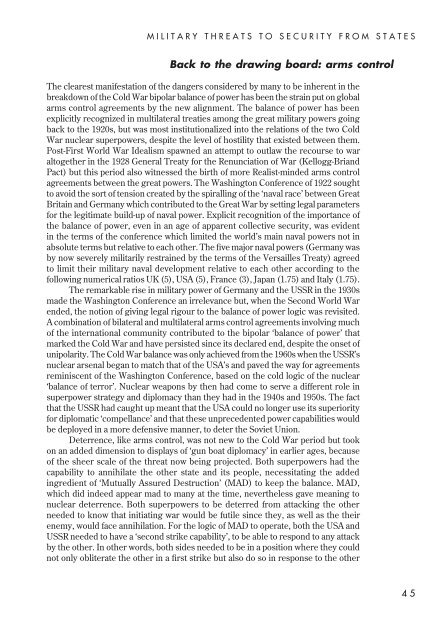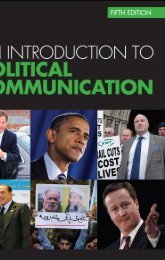Understanding global security - Peter Hough
Understanding global security - Peter Hough
Understanding global security - Peter Hough
Create successful ePaper yourself
Turn your PDF publications into a flip-book with our unique Google optimized e-Paper software.
MILITARY THREATS TO SECURITY FROM STATES<br />
Back to the drawing board: arms control<br />
The clearest manifestation of the dangers considered by many to be inherent in the<br />
breakdown of the Cold War bipolar balance of power has been the strain put on <strong>global</strong><br />
arms control agreements by the new alignment. The balance of power has been<br />
explicitly recognized in multilateral treaties among the great military powers going<br />
back to the 1920s, but was most institutionalized into the relations of the two Cold<br />
War nuclear superpowers, despite the level of hostility that existed between them.<br />
Post-First World War Idealism spawned an attempt to outlaw the recourse to war<br />
altogether in the 1928 General Treaty for the Renunciation of War (Kellogg-Briand<br />
Pact) but this period also witnessed the birth of more Realist-minded arms control<br />
agreements between the great powers. The Washington Conference of 1922 sought<br />
to avoid the sort of tension created by the spiralling of the ‘naval race’ between Great<br />
Britain and Germany which contributed to the Great War by setting legal parameters<br />
for the legitimate build-up of naval power. Explicit recognition of the importance of<br />
the balance of power, even in an age of apparent collective <strong>security</strong>, was evident<br />
in the terms of the conference which limited the world’s main naval powers not in<br />
absolute terms but relative to each other. The five major naval powers (Germany was<br />
by now severely militarily restrained by the terms of the Versailles Treaty) agreed<br />
to limit their military naval development relative to each other according to the<br />
following numerical ratios UK (5), USA (5), France (3), Japan (1.75) and Italy (1.75).<br />
The remarkable rise in military power of Germany and the USSR in the 1930s<br />
made the Washington Conference an irrelevance but, when the Second World War<br />
ended, the notion of giving legal rigour to the balance of power logic was revisited.<br />
A combination of bilateral and multilateral arms control agreements involving much<br />
of the international community contributed to the bipolar ‘balance of power’ that<br />
marked the Cold War and have persisted since its declared end, despite the onset of<br />
unipolarity. The Cold War balance was only achieved from the 1960s when the USSR’s<br />
nuclear arsenal began to match that of the USA’s and paved the way for agreements<br />
reminiscent of the Washington Conference, based on the cold logic of the nuclear<br />
‘balance of terror’. Nuclear weapons by then had come to serve a different role in<br />
superpower strategy and diplomacy than they had in the 1940s and 1950s. The fact<br />
that the USSR had caught up meant that the USA could no longer use its superiority<br />
for diplomatic ‘compellance’ and that these unprecedented power capabilities would<br />
be deployed in a more defensive manner, to deter the Soviet Union.<br />
Deterrence, like arms control, was not new to the Cold War period but took<br />
on an added dimension to displays of ‘gun boat diplomacy’ in earlier ages, because<br />
of the sheer scale of the threat now being projected. Both superpowers had the<br />
capability to annihilate the other state and its people, necessitating the added<br />
ingredient of ‘Mutually Assured Destruction’ (MAD) to keep the balance. MAD,<br />
which did indeed appear mad to many at the time, nevertheless gave meaning to<br />
nuclear deterrence. Both superpowers to be deterred from attacking the other<br />
needed to know that initiating war would be futile since they, as well as the their<br />
enemy, would face annihilation. For the logic of MAD to operate, both the USA and<br />
USSR needed to have a ‘second strike capability’, to be able to respond to any attack<br />
by the other. In other words, both sides needed to be in a position where they could<br />
not only obliterate the other in a first strike but also do so in response to the other<br />
45
















